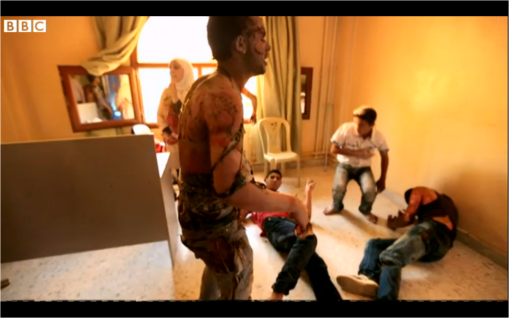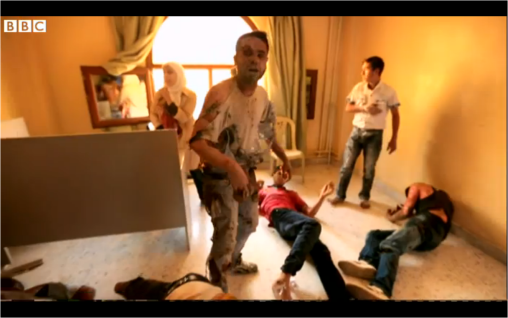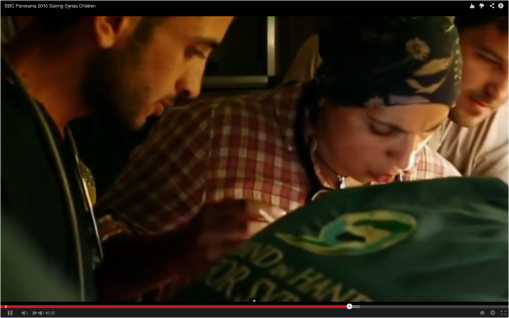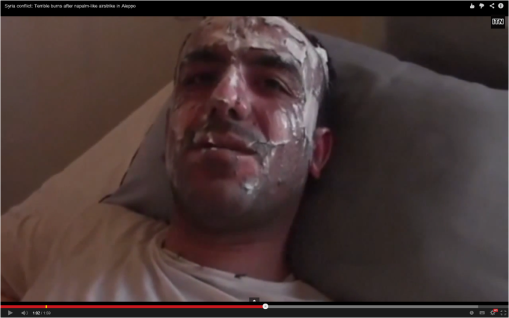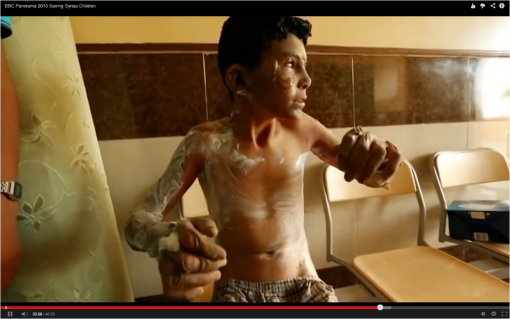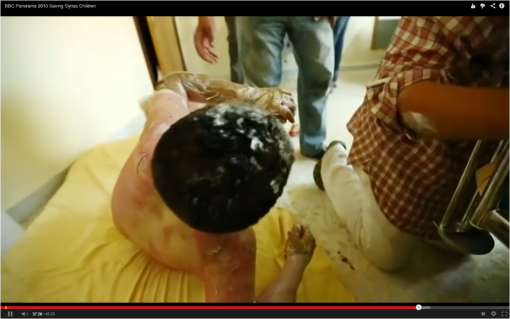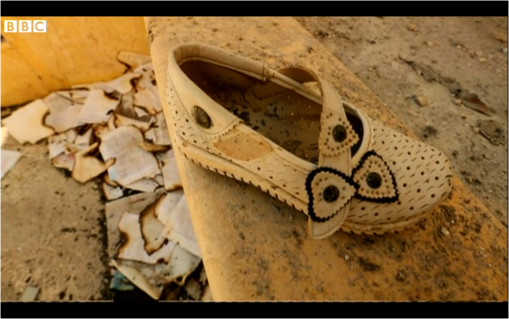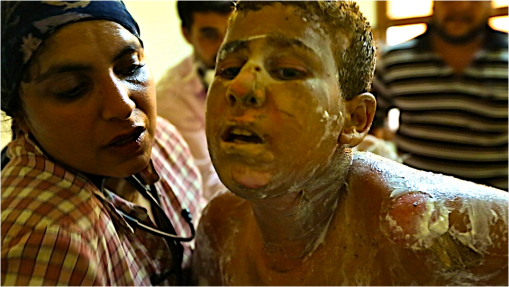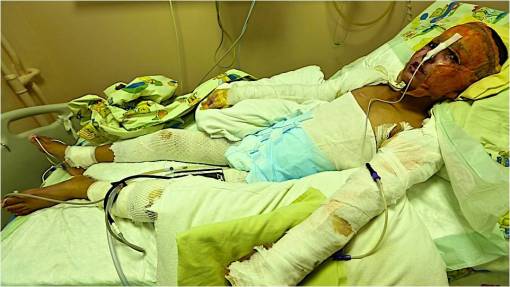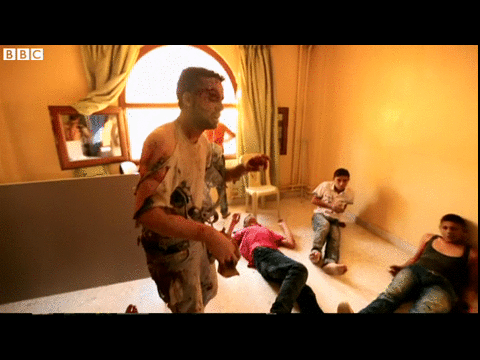 Syria crisis: Incendiary bomb victims ‘like the walking dead’ – Ten O’Clock News, BBC One, 29 August 2013 (03:02 – 03:19). Alleged casualties appear to begin writhing and moaning on cue of central figure.
Syria crisis: Incendiary bomb victims ‘like the walking dead’ – Ten O’Clock News, BBC One, 29 August 2013 (03:02 – 03:19). Alleged casualties appear to begin writhing and moaning on cue of central figure.
Full correspondence with the BBC on Saving Syria’s Children is listed here
Note: The YouTube copy of Saving Syria’s Children linked to in this letter has been blocked by BBC Worldwide, along with all other YouTube copies. A copy of Saving Syria’s Children is available on Vimeo (relevant section commences at 30:38).
For the attention of the BBC Editorial Complaints Unit
Reference: CAS-2541997-BLGF64
I have received this response from BBC Audience Services to my letter of January 30 regarding Panorama ‘Saving Syria’s Children‘ and related BBC News coverage. However, it does not satisfactorily address my concerns and so I wish to take my complaint further.
The primary point of my initial letter on this matter remains. It is self-evident that the section of the BBC News report of 29 August from 03:02 to 03:19, in which the tableau of male alleged victims are static and quiet until spotting that the camera is on them, at which point (03:05) they begin to groan and writhe in unison, is fabricated. (See sequence below and in full here).
In its first reply to me BBC Audience Services indeed conceded that the boy in white (second from right above) who effortlessly stands up and then calmly reaches for a chair (and who is further seen pulling it towards himself and casually taking a seat from 34:19 to 34:27 in Panorama) “appears relatively unscathed”.
It is self-evident that this scene is acted. If one of the hospital scenes is staged, presumably they all are. [1]
Similarly, while I expect the Editorial Complaints Unit to review all the questions raised in both my previous letters, the main points of my 30 January letter remain. Following the section numbers and titles used in my letter and in BBC Audience Services’ reply, in particular these are:
Section 1 – Date of the alleged attack
The references in the captions of the Demotix photos to “napalm” and “students in the Orme countryside of Western Aleppo” (consistent with other accounts of the Panorama incident, which refer to “Orum Alkubra in Aleppo province”, “Awram al-Koubra, outside Aleppo” and “Urm Al Kubra, a village in the Aleppo countryside”) make it clear that they are intended to represent victims of the same alleged napalm bomb attack on the same alleged school [2]. However, the Demotix photos were uploaded on 25 August, the day before the incident featured in Panorama supposedly took place.
Surely another “napalm bomb” on another school or college, in the same area, a day or two before the one featured in Panorama, would have been reported by the BBC and other mainstream media. I can find no such report. I have written to the photographer, Amer Alfaj, via Demotix, to request clarification, but have not to date received a response. The BBC must provide clear evidence for its claim that these photographs represent a separate incident to that featured in ‘Saving Syria’ Children’. Without such evidence, the existence of the Demotix photo set entirely undermines the Panorama narrative.
Note, 20 April 2014: at some point after 16 December 2013 when these screengrabs were made the dates on the Demotix photoset were altered from 25 August 2013 to 26 August 2013. See this detailed discussion.
Section 2 – Discrepancies in the accounts of the first victims to arrive at the hospital
Dr Ahsan is absolutely clear in her ABC interview of 27 November (from 02:44) that the very first victim she encountered was a boy covered in “this strange white dust”, with “a huge laceration on the side of his face”, and who spoke to her, asking her where he should go. Your reply claims that she says that this boy was “one of the first” casualties, but she does not say that at all. Her account is clear – the boy with the laceration was the very first. There is no other possible way of interpreting what she says. This remains entirely irreconcilable with the scenes in Panorama and with all other accounts, including others of Dr Ahsan, in which the first victims Dr Ahsan (or indeed anyone at all) encounters at the hospital are the baby and his father.
Section 3 Discrepancies in the accounts of the baby’s injuries
The baby, who is featured from around 31 minutes in Panorama, does not appear to have suffered “severe burns”, and certainly not the 80% burns that Dr Hallam claims, which, as the high percentage indicates, would cover the vast majority of the baby’s body and would hence be unmistakeable. (See images below, click to enlarge).
Furthermore, if it were indeed the case that the baby had suffered 80% burns, Dr Ahsan’s advice (at 31:18) that “this baby needs to be picked up” and the child’s subsequent robust handling by both Dr Ahan and the father would seem to be extremely reckless and to pose a grave risk to the infant.
Section 5 – Discrepancies in the accounts of the father’s injuries
The baby’s father (seen with perfect clarity over Dr Ahsan’s left shoulder at 31:16 and then again holding the baby at 31:31) is vigourous, animated and vocal, and seems entirely unscathed. This remains in stark contradiction to Ian Pannell’s BBC News description of the father who “was also burnt and sat helplessly on a stretcher clutching his son” and to Dr Hallam’s description (from 22:17), in which he “also had a burnt face”.
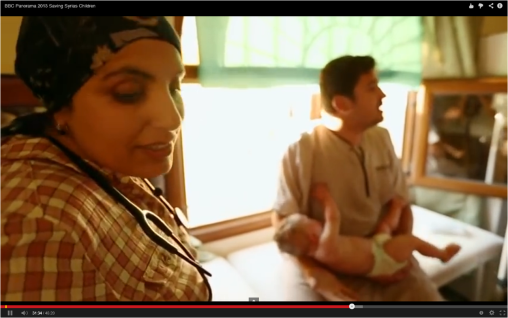
The baby’s father, who according to Ian Pannell “was also burnt and sat helplessly on a stretcher clutching his son”
Section 6 – All alleged victims retained their eyebrows
This alleged teacher interviewed in ITN-screened footage of the same incident is typical of other alleged victims seen in Panorama in that his eyebrows are pristine, despite the white cream suggesting treatment for facial burns. This person would seem to be the man in the white t-shirt referenced in note [1] below. (This note added 5 April 2014)
With regard to the questions I have raised about the alleged injuries depicted in Panorama (specifically in sections 3, 4, 5, 6, 7, 8, 11 and 12), it is now clearly absolutely incumbent upon the BBC to solicit independent medical opinion as to:
a) The plausibility or otherwise of the alleged injuries as having resulted from the “napalm-type substance” that you assert was their cause, bearing in mind that “Napalm generates temperatures of 800 to 1,200 degrees Celsius (1,500-2,200°F)” and that “it sticks to human skin, with no practical method for removal of the burning substance”. [3]
b) The plausibility or otherwise of the demeanour of the alleged victims seen in Panorama, bearing in mind that Kim Phúc, a napalm bombing survivor known from a famous Vietnam War photograph, has stated that “Napalm is the most terrible pain you can imagine”.
c) The plausibility or otherwise of the deterioration of the alleged injuries in each individual case, and particularly in those of Mohammed Kanas, Anas Said Ali and Lutfi Arsi, as depicted as having occurred during the “four to five hour period” in which the Panorama crew filmed in the Aleppo hospital.
d) The plausibility or otherwise of the deterioration of the alleged injuries of Siham Kanbari and Ahmed Darwish as depicted as having occurred between the day of the alleged attack and the scenes filmed “a few weeks after the attack in hospital in Turkey”; and of the plausibility or otherwise of the deterioration of the alleged injuries of Mohammed Asi as depicted as having occurred between the day of the alleged attack and the photograph provided in your latest reply which purports to show him “two weeks after the attack in hospital in Turkey”.
e) The plausibility or otherwise of the demeanour of those whom you allege to have been administered with morphine and/or fentanyl, in particular Lutfi Arsi during his many appearances (including at 32:26 ambling in the yard; at 34:19 bobbing and weaving his head; at 37:51 walking, attached to a drip; and at 38:13 where he is alert and inquisitive, and sits up to peer at the camera) and the woman in the black dress during her energetic display of emotion from 36:01 to 36:24, who may or may not be the same person giving a cogent and animated interview from 0:17 in this Al Jazeera footage.
I will make some further brief comments on BBC Audience Services’ latest response. Please note that omission of sections does not in any way indicate that I am satisfied with the BBC’s responses in those instances, only that I have no further observations to add to those I have already made. As noted above, I expect the Editorial Complaints Unit to review in full all the questions and issues raised in both my previous letters.
Section 7 – Teenagers who allegedly died appear among the least injured
Your response here clarifies that the shirtless boy in the yard at 32:26, also seen later at 37:25, at 37:51 (attached to a drip), and at 38:13 (where his alleged injuries are discussed by Dr Ahsan and Dr Hallam), is Lutfi Arsi, identifiable elsewhere by his yellow ‘Super 9’ t-shirt.
This further demonstrates the point I make in section 16 regarding the extreme extent to which sequences in Panorama are shown non-chronologically: it is now clear that Arsi’s earliest appearance in Panorama, in the yard at 32:26, shows him at an even later stage in his alleged treatment at the hospital than I had previously understood.
Your clarification regarding Lutfi Arsi also demonstrates the extent to which the same alleged victims are “recycled” in the footage. As far as I have been able, I have counted around 20 individual alleged victims featured in the hospital sequences; it possible that, as demonstrated by my confusion over Arsi, there are fewer than this. This does not bear out your assertion (in your response to section 9) that “more than thirty were injured”, particularly bearing in mind (as you state in your response to section 16) that the Panorama crew were present for the entire four to five hour duration of the alleged event at the hospital.
With regard to the plausibility of the alleged injuries depicted, their deterioration, and the demeanour of those allegedly administered morphine and/or fentanyl, as stated above it is incumbent upon the BBC to solicit independent medical opinion.
Section 8 – Other discrepancies relating to the injuries of alleged victims
With regard to the plausibility of the alleged injuries depicted, their deterioration, and the demeanour of those allegedly administered morphine and/or fentanyl, it is incumbent upon the BBC to solicit independent medical opinion.
I would further draw attention to Ahmed Darwish’s hands, as visible from 33:47 to 34:00, and those of Lutfi Arsi, as visible at 32:26 (in the yard) and 37:25 (rocking on the bed). Dr Ahsan says of Ahmed Darwish’s hands “the skin was falling off as if he had been peeled”. I would suggest the appearance in both cases is rather of prosthesis.
Section 9 – Discrepancies in the accounts of numbers of alleged dead and injured
You say you were shown “blackened corpses”. Can you confirm that these were the corpses of children? As stated in my first letter, it would seem far more plausible that the “school” is in fact a residential building which may well have been the scene of a shelling or explosion of some kind (although, from the limited damage depicted, certainly not of the magnitude of an aerial bombardment), and where there may well have been fatalities, although not necessarily children.
Section 11 – Same woman depicted arriving twice at the hospital
With regard to the plausibility of the alleged injuries of the woman in the black and gold dress, and the plausibility or otherwise of her demeanour with regard to your claim that she “would have been administered morphine and fentanyl”, it is incumbent upon the BBC to solicit independent medical opinion.
You give the reason for showing the two shots of the woman (bizarrely ranting at the gate in the first, being transported into the hospital by stretcher in the second) “in the opposite order” as being so that “people could remember her as she was being rushed into the hospital”. This makes scant sense, as it is only upon very close scrutiny that it is clear that these shots feature the same individual. (After several viewings, I had mistakenly identified the woman as two separate individuals in paragraph 12 of my first letter).
Section 12 – Discrepancies relating to Anas Said Ali
With regard to the plausibility of the alleged injuries depicted and their deterioration, it is incumbent upon the BBC to solicit independent medical opinion.
Section 13 – Number of bombs
With reference to the alleged earlier bombing of a residential dwelling, your reply states “When the first patients arrived it was unclear what had happened”. This is untrue. As I have pointed out, Dr Hallam makes it plain (from 22:17) that, upon his arrival at the hospital, the baby’s father “was telling us about how a plane had flown over their house and suddenly his house caught fire”. Bearing in mind the close relationship between the Panorama crew and Drs Hallam and Ahsan, and their continuing association after the alleged events of 26 August (including travelling to the “school” together, as you state in your reply to section 20), it is entirely implausible that this information should not have been available to Ian Pannell and Darren Conway, and incomprehensible that it should be omitted from ‘Saving Syria’s Children’ and all BBC News coverage of this alleged incident.
Section 20 – Dr Ahsan’s visit to the school
Of the subsequent visit to the school by the Panorama team (which included Dr Ahsan and Dr Hallam) you state “There was a substance that had dried and hardened on the walls… It is possible that this was the after effect of the gel hardening, but we are not experts and can only report what we saw.” However in her account of the visit Dr Ahsan is clear that “We saw a white gel, clinging to the walls”, i.e. specifically not a “dried and hardened” substance which was possibly the “after effect of the gel hardening”.
Finally, to be absolutely clear, I must insist that the BBC Editorial Complaints Unit addresses the several points and questions in both of my previous letters which BBC Audience Services has entirely ignored in its two replies. These are the points numbered 1 – 6 in the first part of my letter of 30 January along with my request for a full explanation of the editing of Dr Hallam’s words between the BBC News reports of 29 August and 30 September. I repeat these points here:
1) Why has the BBC at no point in its coverage – which has included providing Dr Rola Hallam with a platform on Newsnight to espouse pro-intervention sentiments – felt it necessary to inform its viewers of the pro-Syrian opposition affiliations of Dr Hallam and of her charity Hand in Hand for Syria?
In reply to a question about her father, Dr. Mousa al-Kurdi, at a Save the Children event on 27 November 2013 Dr Hallam stated (at just after 51 minutes) “he is certainly not a member of the Syrian National Council; he is a gynaecologist, who like most Syrians has taken an interest in what’s happening in his country”. [4]
However an article written by Dr Ahsan in February 2013 states that Dr Hallam’s father is “involved politically with the Syrian National Council”.
The same article states that Hand in Hand for Syria was “formed by members of the Syrian diaspora”. As I noted in my first letter, the fact that the Hand in Hand for Syria logo is based on the adopted flag of the Syrian National Council and the Free Syrian Army is abundantly plain, and was not disputed by Dr Hallam at the Save the Children event. [5]
For the BBC to conceal these political affiliations is fraudulent.
2) Is it plausible to describe the scene of the alleged “incendiary bomb” attack as a school? Is it not far more likely a private residence (a villa, according to this Arab language site) – note the swimming pool – which has been stage-dressed with an undamaged toddlers’ swing, a child’s shoe (neither of which match the age of the “students” seen in Panorama) and charred scraps of schoolbooks? (See from 40:52 and images below). Independent investigation is clearly called for.

Undamaged toddlers’ swing which does not match the age of any of the alleged victims featured in Panorama
3) Can the very limited damage on view in the “playground” (see above) be plausibly be ascribed to an incendiary bomb which, as Wikipedia notes, is capable of damaging an area of 2,500 square yards? Independent investigation is clearly called for.
4) Does 26 August, the date of the alleged attack, fall inside the Syrian school calendar? If it does not, why was this particular “school” open during the summer holidays? Is the same Arab language site cited above correct in stating (in September 2013) that there are “no schools now in operation in Syria, whether public or private”?
5) Can the alleged injuries depicted in Panorama be plausibly ascribed to a “napalm-type substance”? As noted above, independent medical opinion is clearly called for.
6) Was BBC presenter, filmmaker and journalist Dr Saleyha Ahsan involved in the production or editing of any of the Panorama footage?
7) BBC Audience Services’ account (from paragraph 9) of the editing of Dr Hallam’s words between the BBC News reports of 29 August and 30 September does not explain why the images do not match even prior to the point where the variation in the soundtrack occurs. In this comparison of the two reports, at 24 seconds, as Dr Hallam finishes saying “..some sort of” – i.e. before any editing of her words has occurred – the images on screen are different. Most notably, there is a figure in the background in the 30 September version. Please can you explain why there is this difference in the visuals? Was more than one take of Dr Hallam’s interview made? Was more than one camera person involved in this section, and if so, who were they?
Please answer these points 1 – 7 in full, and solicit independent investigation or medical opinion where noted.
I shall be contacting the police to request they investigate this matter.
Yours sincerely
Robert Stuart
Notes
[1] Equally as implausible as the behaviour of the males in the “tableau” scene is that of the man in the white t-shirt (second from left below) in the segment of Panorama from 33:38 to 33:46. This person would appear to be the alleged teacher pictured above (Section 6) and who is interviewed in this ITN-screened footage. (This note added 5 April 2014)
The demeanour of the person with the exposed back (centre, above) seems remarkably placid as he walks behind Ian Pannell at 33:22 and stands stock still for at least 20 seconds, bearing out former UK ambassador Craig Murray’s observation on the Panorama report: “having personally been in my career in rather similar conflict situations, I was struck by the strange absence of panic and screaming both by patients and surrounding family – I have seen people in that sort of pain and situation and they are not that quiet and stoic, in any culture.” (This note added 9 April 2014)
[2] I did not, as you suggest, claim that these photos were taken at Hand in Hand’s hospital, nor that they show the same alleged victims featured in Panorama. You indeed state in your response to section 9, “We know some of the victims did not come to this particular hospital”.
[3] Video of burning napalm from 01:44 here.
[4] In 2012, as Chairman of the Arab Institute for Clinical Excellence, Dr al-Kurdi addressed the Friends of Syria summit, as reported by Aljazeera. Dr Hallam’s father is therefore clearly someone who does far more than merely take “an interest in” events in Syria.
[5] Hand in Hand for Syria has recently removed the three red stars from its logo, however the previous version can readily be found using Google image search. (this footnote added 19 March 2014)






